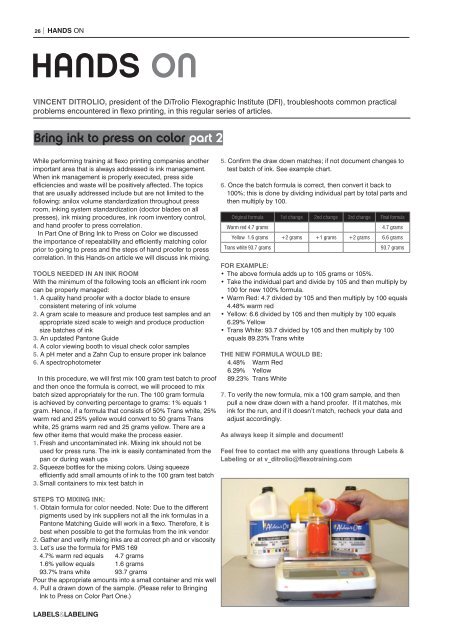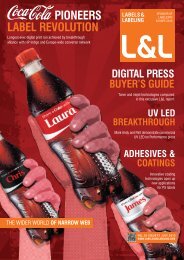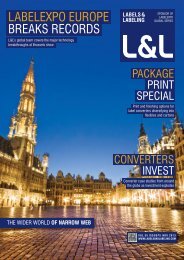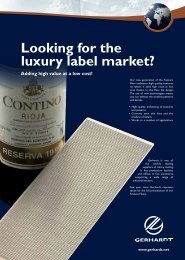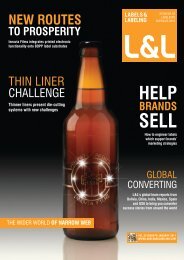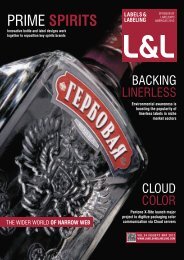THE DATA FRONT
Download as PDF - Labels & Labeling
Download as PDF - Labels & Labeling
- No tags were found...
You also want an ePaper? Increase the reach of your titles
YUMPU automatically turns print PDFs into web optimized ePapers that Google loves.
26 | hands on<br />
Hands on<br />
Vincent DiTrolio, president of the DiTrolio Flexographic Institute (DFI), troubleshoots common practical<br />
problems encountered in flexo printing, in this regular series of articles.<br />
Bring ink to press on color part 2<br />
While performing training at flexo printing companies another<br />
important area that is always addressed is ink management.<br />
When ink management is properly executed, press side<br />
efficiencies and waste will be positively affected. The topics<br />
that are usually addressed include but are not limited to the<br />
following: anilox volume standardization throughout press<br />
room, inking system standardization (doctor blades on all<br />
presses), ink mixing procedures, ink room inventory control,<br />
and hand proofer to press correlation.<br />
In Part One of Bring Ink to Press on Color we discussed<br />
the importance of repeatability and efficiently matching color<br />
prior to going to press and the steps of hand proofer to press<br />
correlation. In this Hands-on article we will discuss ink mixing.<br />
Tools needed in an ink room<br />
With the minimum of the following tools an efficient ink room<br />
can be properly managed:<br />
1. A quality hand proofer with a doctor blade to ensure<br />
consistent metering of ink volume<br />
2. A gram scale to measure and produce test samples and an<br />
appropriate sized scale to weigh and produce production<br />
size batches of ink<br />
3. An updated Pantone Guide<br />
4. A color viewing booth to visual check color samples<br />
5. A pH meter and a Zahn Cup to ensure proper ink balance<br />
6. A spectrophotometer<br />
In this procedure, we will first mix 100 gram test batch to proof<br />
and then once the formula is correct, we will proceed to mix<br />
batch sized appropriately for the run. The 100 gram formula<br />
is achieved by converting percentage to grams: 1% equals 1<br />
gram. Hence, if a formula that consists of 50% Trans white, 25%<br />
warm red and 25% yellow would convert to 50 grams Trans<br />
white, 25 grams warm red and 25 grams yellow. There are a<br />
few other items that would make the process easier.<br />
1. Fresh and uncontaminated ink. Mixing ink should not be<br />
used for press runs. The ink is easily contaminated from the<br />
pan or during wash ups<br />
2. Squeeze bottles for the mixing colors. Using squeeze<br />
efficiently add small amounts of ink to the 100 gram test batch<br />
3. Small containers to mix test batch in<br />
Steps to mixing ink:<br />
1. Obtain formula for color needed. Note: Due to the different<br />
pigments used by ink suppliers not all the ink formulas in a<br />
Pantone Matching Guide will work in a flexo. Therefore, it is<br />
best when possible to get the formulas from the ink vendor<br />
2. Gather and verify mixing inks are at correct ph and or viscosity<br />
3. Let’s use the formula for PMS 169<br />
4.7% warm red equals 4.7 grams<br />
1.6% yellow equals 1.6 grams<br />
93.7% trans white 93.7 grams<br />
Pour the appropriate amounts into a small container and mix well<br />
4. Pull a drawn down of the sample. (Please refer to Bringing<br />
Ink to Press on Color Part One.)<br />
5. Confirm the draw down matches; if not document changes to<br />
test batch of ink. See example chart.<br />
6. Once the batch formula is correct, then convert it back to<br />
100%; this is done by dividing individual part by total parts and<br />
then multiply by 100.<br />
Original formula 1st change 2nd change 3rd change Final formula<br />
Warm red 4.7 grams<br />
For example:<br />
• The above formula adds up to 105 grams or 105%.<br />
• Take the individual part and divide by 105 and then multiply by<br />
100 for new 100% formula.<br />
• Warm Red: 4.7 divided by 105 and then multiply by 100 equals<br />
4.48% warm red<br />
• Yellow: 6.6 divided by 105 and then multiply by 100 equals<br />
6.29% Yellow<br />
• Trans White: 93.7 divided by 105 and then multiply by 100<br />
equals 89.23% Trans white<br />
The new formula would be:<br />
4.48% Warm Red<br />
6.29% Yellow<br />
89.23% Trans White<br />
7. To verify the new formula, mix a 100 gram sample, and then<br />
pull a new draw down with a hand proofer. If it matches, mix<br />
ink for the run, and if it doesn’t match, recheck your data and<br />
adjust accordingly.<br />
As always keep it simple and document!<br />
4.7 grams<br />
Yellow 1.6 grams +2 grams +1 grams +2 grams 6.6 grams<br />
Trans white 93.7 grams<br />
93.7 grams<br />
Feel free to contact me with any questions through Labels &<br />
Labeling or at v_ditrolio@flexotraining.com<br />
Labels&Labeling


